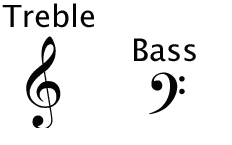Being able to read music isn't as hard as everyone thinks. Now, it's not extremely simple, but it's not overly complicated either. However, we aren't talking about riding a bike here. Once you learn, you are capable of forgetting. You need to stick with it and practice if you want to understand that jumble of symbols.
I'll start with the foundation of sheet music, what everything else starts on ? the staff.

The staff is made up of five lines and four spaces . . . and that's about it. Notes, clefs, time signatures, etc., will all be placed on or before those lines and spaces.
When looking at sheet music, you'll notice the first symbol, a clef.

As indicated in the picture, the first one is the treble clef (also known as the G clef) and the other one is the bass clef (also known as the F clef). There is another clef but it's uncommon and you won't find it until you're far down the road.
When using sheet music for piano, the treble clef indicates the upper staff, and the bass the lower one in the grand staff.
Both clefs have a set of notes that go on their staffs.

Those are the notes on the treble clef - of course, you can go off the staff lines, but we'll get to that later. Now, how are you supposed to remember these notes? Easy! For the notes on the lines, memorize the following phrase:
Every
Good
Boy
Does
Fine
See? It's simple. For the notes on the spaces, they already spell a word - face!
F
A
C
E
What about the bass clef?

And it's just as easy! Memorize the phrases as follows:
Good
Burritos
Don't
Fall
Apart
Those notes are on the lines, and the ones below this are situated on the spaces.
All
Cows
Eat
Grass
To recap: the staff is what all the others parts of sheet music sit on ? it's made up of five lines and four spaces. The two main and most common clefs are the treble (G) clef and the bass (F) clef. On the treble clef, the notes are E, F, G, A, B, C, D, E, F. On the bass clef the notes are G, A, B, C, D, E, F, G, A.
Make sure to memorize all of this!
'Til next time,
PopofTart